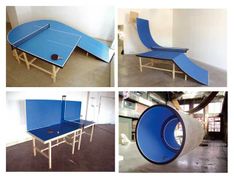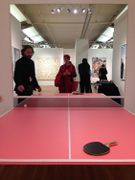Project Proposal: Interactive tabletennis: Difference between revisions
No edit summary |
No edit summary |
||
| Line 53: | Line 53: | ||
TabletennisBen2.jpg | Gabriel Orozco: Ping-Pond Table (1998), Deformed Ping-pong Tables, Ping Pong Rackets, Ball, Water tank, pump filter, water lelies, H76,7xW42,5xD424,5 cm | TabletennisBen2.jpg | Gabriel Orozco: Ping-Pond Table (1998), Deformed Ping-pong Tables, Ping Pong Rackets, Ball, Water tank, pump filter, water lelies, H76,7xW42,5xD424,5 cm | ||
Laurent-perbos.jpg | Laurent Perbos - J.O. (2003), Hout, Acrylverf, Tafeltennis bats, 306x274x76 cm | Laurent-perbos.jpg | Laurent Perbos - J.O. (2003), Hout, Acrylverf, Tafeltennis bats, 306x274x76 cm | ||
tabletennisBen3.jpg | |||
Lee-Wen-Ping-Pong-Go-Round.jpg | Lee Wen: Ping Pong Go-round (2013): Performance and Mixed Media, 580x76cm | |||
</gallery> | </gallery> | ||
Revision as of 15:54, 21 September 2015
INTERACTIVE PEDDLES AND TABLE TENNIS
ABSTRACT/PROJECT DESCRIPTION:
Interactive table tennis is a project where I want to harvest the energy participants consume/loose while playing table tennis and turn this energy into outcomes. For this project I want to make or customise a tabletennis table (or make one myself) and the peddles by adding different sensors. When people play (interact) the sensors pick up differences in status. When it reaches a certain threshold an action is triggered. This action will lead to an outcome. The outcome can be the start of a sound or image or be used to start up a chain of other actions.
THE TABLE AND THE PEDDLES:
Sensors will be applied both on the table and the peddles. The table will have several piezo’s connected to Arduino’s on both sides of the net. When the ball hits the surface, the piezo detect the vibration. This vibration will trigger, when reached the threshold, an action.
The peddles will have several different sensors with possibly different actions. A piezo beneath the surface of the rubber layer will detect the hit of the ball to the surface of the peddle. An tilt-sensor will detect differences in positions of the peddle and a touch-sensor will detect the amount of pressure the player uses when holding the peddle.
THE ROLE OF THE HUMAN:
People want to be stimulated to experience a state of happiness. To be or stay happy people do different sort of things. This can be the use of substances to mental and physical activities. I assume that playing tabletennis is a physical activity that can make people happy. I expect people to interact with my project voluntary because of their own needs.
HUMAN AS BATTERY:
like machines need electricity, humans need energy too. Whatever we do we burn calories. So when people interact with my project they gradually loose their energy. To regain energy humans need to eat, drink or rest. Because of that I see the human as a battery that needs to charge itself to maintain life. The role of the human as a battery is emphasised in my project by the fact that without the human, there is no trigger to activate. In my project it is not about the human, it is about the triggers that are activated by human labour. To have a continuation in my project humans need to be replaced by others. The human is a battery, interactive tabletennis needs batteries to be productive.
HUMAN AS SLAVE:
Humans like to have fun. Therefor I expect them to interact with the interactive tabletennis. It is free to participate and people can chose when and how long they want to play. In this sense humans are no slaves.
In my opinion humans become slaves when the outcome of playing tabletennis is that of monetary reward. i will write more about the outcomes of interacting with tabletennis in a later section, but when people know they can gain something they will do or continue it.
OUTCOME:
OPTION 1:
In this version the outcome are visuals, sounds and lights. Every sensor can be assigned to one of these outcomes. I believe that in this version I can control for example a disco.
OPTION 2:
This is secret, don't dare to write it here. But it would be nice to talk a bit about this.....





